List of Contents
Commercial Greenhouse Market Size and Forecast 2025 to 2034
The global commercial greenhouse market size was estimated at USD 38.22 billion in 2024 and is anticipated to reach around USD 93.87 billion by 2034, expanding at a CAGR of 9.40% from 2025 to 2034.
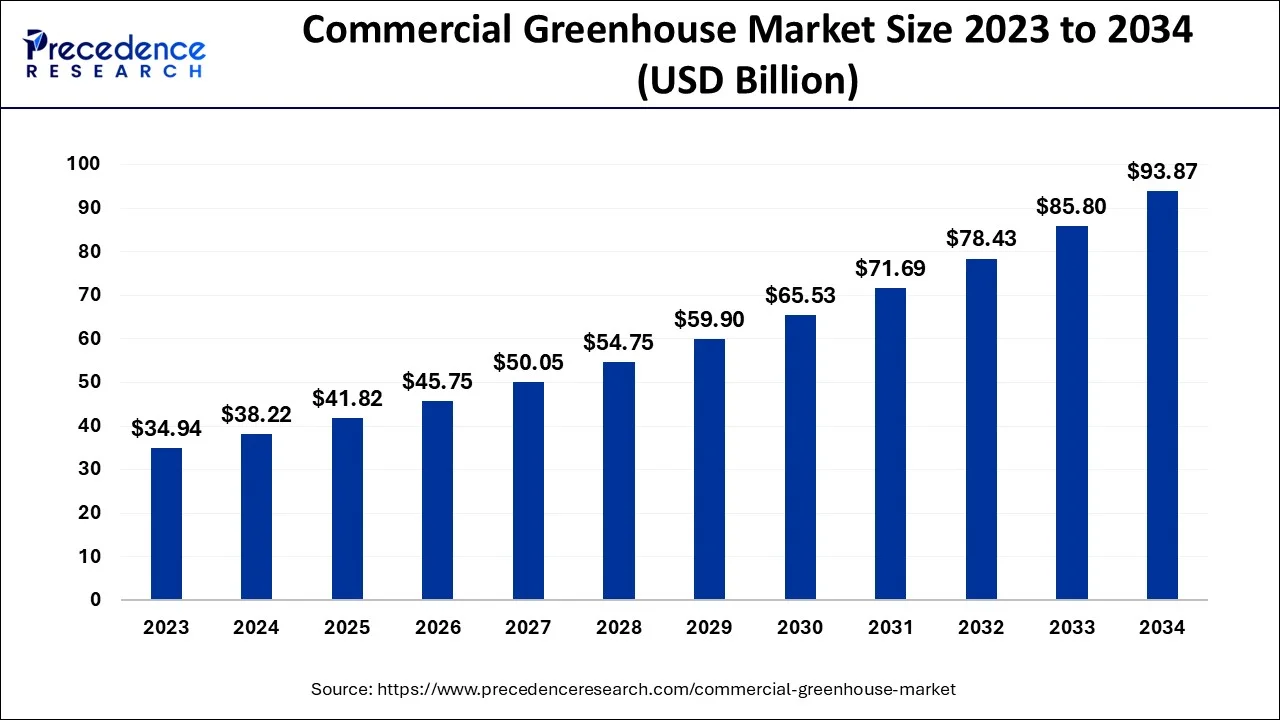
Commercial Greenhouse Market Key Takeaways
- The vegetables segment hit a market share of over 42% in 2024.
- The fruits segment garnered a market share of over 25.3% in 2024.
- The flowers & ornamentals segment accounted market share of over 16.5%.
- North America accounted highest market share of over 33% in 2024.
U.S. Commercial Greenhouse Market Size and Growth 2025 to 2034
The U.S. commercial greenhouse market size is evaluated at USD 8.83 billion in 2024 and is predicted to be worth around USD 22.17 billion by 2034, rising at a CAGR of 9.64% from 2025 to 2034.
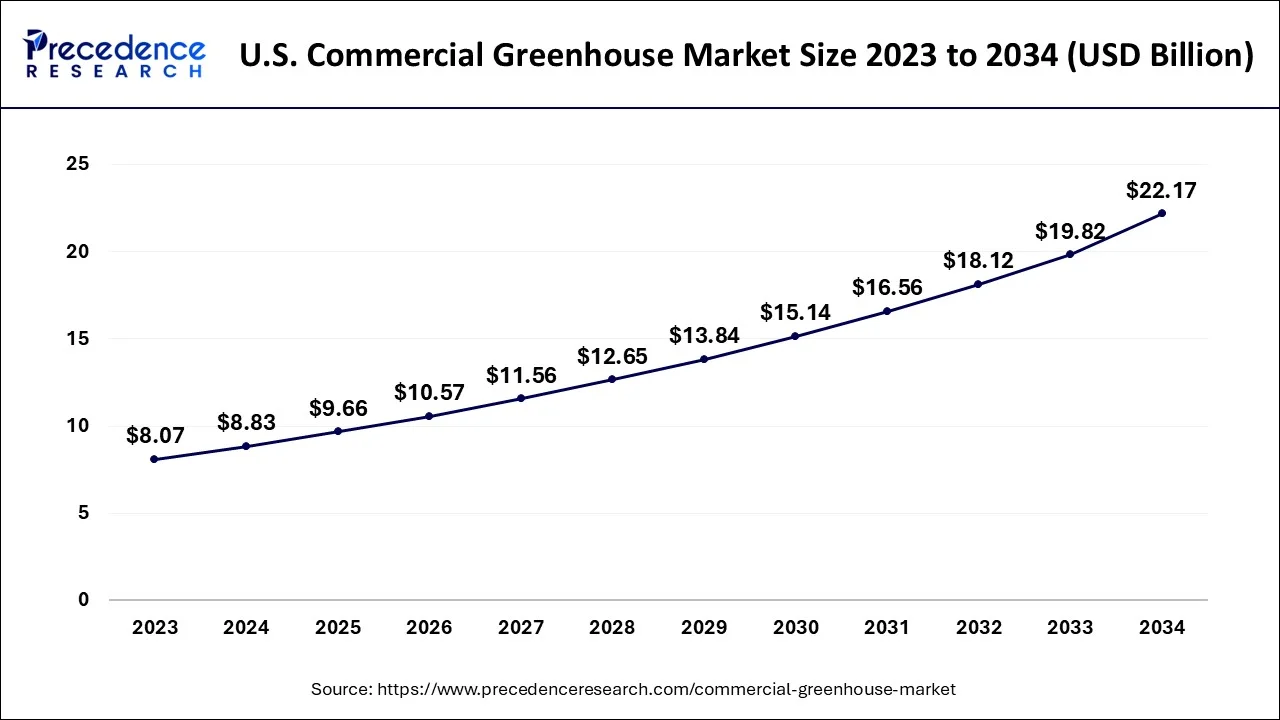
North America is Leading with Smart Farming and Innovation
North America continues to dominate the commercial greenhouse segment, driven by adoption of smart farming technologies and support from institutions. In early 2024, the U.S. Department of Agriculture launched $90 million in grants financing climate-smart greenhouse projects. Companies like IUNU and AppHarvest have scaled their AI-driven monitoring systems to increase crop yields — particularly in tomatoes and leafy greens.
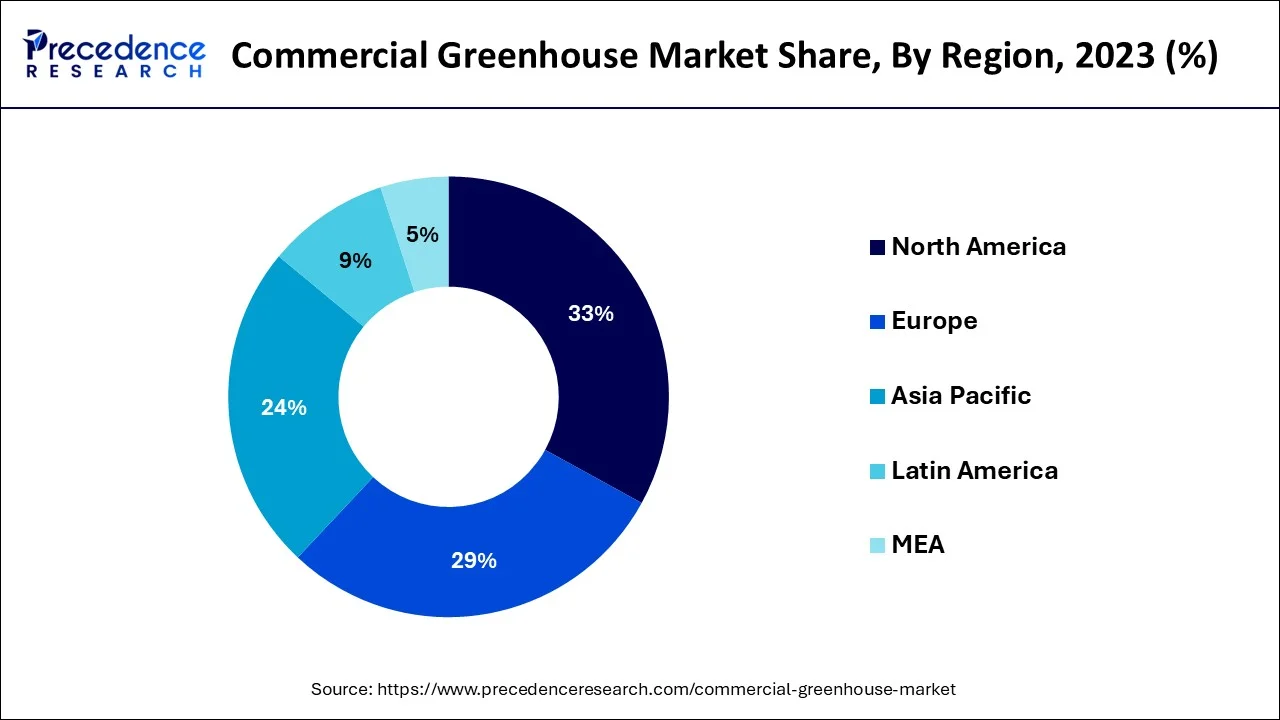
The Fastest Growth of Asia-Pacific is Fueled by Tech Adoption and Urban Demand
Asia-Pacific is experiencing the fastest growth led by China, which has a significant greenhouse footprint with 4 million hectares. As of early 2025, over 60% of new greenhouses in Asia were being constructed with advanced climate control systems, leading to enhanced yield and reduced use of resources. Growing urban demand for pesticide-free produce in India, Japan, and Southeast Asia has intensified investments in hydroponic and vertical greenhouse systems throughout the region.
Market Overview
Consumers can grow flowers, fruits, vegetables, and transplants for planting in commercial greenhouses, which provide highly controlled and stable environments. Because of this, greenhouse plants can reliably produce despite regional temperature, soil, or terrain restrictions. In commercial greenhouses, plants are often produced in large quantities for consumers. Farmers have more control over the environment in which their crops grow because to greenhouse farming.
The commercial greenhouse market is expanding mostly due to rapid urbanization and a lack of available arable land. Additionally, the development of commercial greenhouses is a result of the shifting weather patterns that affect conventional farming. More control over the environment in which crops grow is provided through the use of greenhouse farming. A good yield is possible for farmers if they can effectively control the temperature, the irrigation system, the air humidity, and the light. Farmers can estimate how much they will harvest and keep their crops healthier by having that much control over their growth. Farmers are able to grow flowers, vegetables, and fruit crops all year round thanks to their capacity to manage the environment.
Crop genetics can be enhanced by growing them in the controlled atmosphere of a greenhouse, encouraging the development of wholesome cultivars. In addition, less water is required than in an open field. Producers may use all the herbicides and pesticides they need to prevent illnesses and any other plant vulnerabilities because they are not dependent on bees for pollination. In an open field, insects, animals, and locusts may pose a threat to the produce's quality. Due to the controlled medium and environmental factors, crop cycles in greenhouse farming are also quicker than in traditional agriculture, with vine crop productivity more than twice as high. Additionally, compared to traditional agriculture, vertical farming has a land productivity that is more than twice as high and twice as quick. However, there are several obstacles that could limit market expansion, including the need for precise technology in a regulated growth environment and the expensive setup costs.
Key regulation and compliance in 2025
Building Codes & Structural Standards
Environmental concerns, fire safety, and structural integrity are all covered by local and federal building codes that commercial greenhouses must follow. According to the International Building Code, for example, greenhouses fall under the miscellaneous use group and must adhere to strict wind and snow load requirements. For safety and longevity, designs frequently adhere to the National Greenhouse Manufacturers Association (NGMA) standards. Polyethylene films and polycarbonate sheets are examples of materials that must adhere to fire safety regulations and structural specifications suitable for their intended use.
Commercial Greenhouse Market Growth Factors
Rapid urbanization and a lack of arable land are driving the growth of the commercial greenhouse industry. The employment of commercial greenhouses in conventional farming has also been encouraged by changing weather patterns, and this trend will spur the market's expansion even further. Additionally, one of the main factors influencing the growth of commercial greenhouses is their ability to produce high yields in compared to conventional agricultural methods. Another important aspect is the expanding population, which will slow the market's growth pace and increase the need for food. Additionally, the market for commercial greenhouses would benefit from expanding floriculture and decorative horticulture applications as well as rising demand for fruits and vegetables in underdeveloped countries.
Market Scope
| Report Coverage | Details |
| Market Size in 2024 | USD 38.22 Billion |
| Market Size in 2025 | USD 41.82 Billion |
| Market Size by 2034 | USD 93.87 Billion |
| Growth Rate from 2025 to 2034 | CAGR of 9.40% |
| Base Year | 2024 |
| Forecast Period | 2025 to 2034 |
| Segments Covered | Equipment, Crop Type, Type, Component, and Geography |
Market Dynamics
Key Market Drivers
Higher yields are required while using less water and space
- Less water and area are needed to produce the same amount of produce when using greenhouse farming, which is one of its key advantages over traditional agricultural practices. The Food and Agriculture Organization of the United Nations estimates to meet global food demand, food output must rise by 70% by 2050. Greenhouse farming is a possible solution to assist fulfill the rising population's demand for food because urbanization is displacing arable land and reducing the overall amount of agricultural land. Compared to traditional farming, organic farming wastes less water. In general, greenhouse farming uses 95% less water than outside farming for the same amount of crops. In vertical greenhouses, the transpiration process happens when commodities or plants are produced, allowing farmers to reuse the water for irrigation.
A small number of crops are suited for greenhouse farming
- Growing in a greenhouse is not a popular option among producers because it only works for a few types of crops. A lot of things need to be considered before establishing a greenhouse plantation, including temperature control, adequate water supply management, identification and supply of fertilizer, the growth mechanism to be employed, and specific harvest timings for plants. Fruits and vegetables are the finest crops for vertical farming since they grow more quickly and require less water and light. However, there are just a few fruit and vegetable species that can be grown in regulated environments. For instance, many fruits and vegetables have edible branches, roots, and leaves. Vertical farming is not a good fit for these kinds of plants. In greenhouses, it is difficult to produce crops like sugarcane, rice, and wheat since they require a lot of water and take a long time to harvest. Wheat and rice are two important crops that are produced year-round in the APAC area to feed the region's expanding population. The limited adoption of commercial greenhouse farming in these areas is a result of the challenges associated with cultivating these crops in greenhouses.
Market Growth Driven by Increased Demand for Local, Pesticide-Free Products
- A growing consumer preference for fresh, locally grown, and pesticide-free fruit and vegetables represents an opportunity for the commercial greenhouse sector. The increasing urban population, seeking sustainable sources of food, allows for continued investment in advanced greenhouse environments that support growers in meeting the increasingly health-conscious consumers' expectations with minimal impact to the environment, demonstrating that greenhouses have similar potential to traditional agriculture.
Market Challenges
High Capital Expenditure - Crops grown in greenhouses require particular environmental conditions in order to grow properly. It is crucial to keep an eye on the ideal air quality, temperature, and relative humidity. They require the best possible light and water for growth. According to the requirements of each crop's growth stage, the nutrient levels available to the plants should be regularly monitored and gradually changed to the proper levels. Monitoring and precision of natural resources and fertilizers are essential for growing crops in greenhouses. This entails having a thorough awareness of the crop, the surrounding environment, and the plants' ideal requirements. As a result, these crops are frequently grown properly by expert farmers. The right setup and additional illumination of the irrigation systems are among the other factors. All of these are expensive and difficult for conventional farmers to perform, especially in developing nations.
Market Opportunities
- R&D projects to advance greenhouse agricultural techniques - The majority of scientific R&D is focused on the agricultural sector. The difficulties created by environmental problems and climate change have motivated the development of several ways to ensure food security on a worldwide scale. Interest in greenhouse farming is growing among researchers, academics, and farmers. Experts are working to adopt greenhouse farming in an effort to address the basic problem of managing the climate in temperate zones. The Advanced Horticulture Research Facility claims that active cooling methods might aid in producing the perfect environment. Many strategies are being investigated, including shading methods based on photovoltaic (PV) technology for greenhouse passive cooling. The methods used by the protected cropping sector to regulate humidity are being improved, and experts are identifying new directions for further study in this area.
- Technological innovations - Artificial intelligence, smart irrigation systems, pH monitors, and temperature control software are just a few of the technological advancements that are significant trends in the commercial greenhouse sector. Artificial intelligence, autonomous watering systems, pH sensors, and climate change technologies may be used by indoor farmers to address issues like disease prevention and pest control. For instance, a US-based agriculture firm will introduce LUNA in 2019; it is an optical scanning system run by inch, a US-based company that continuously records imagery in greenhouses and analyzes visual data from growth cycles. The application has the ability to identify crops that are stable and notify farmers when problems occur. High-tech greenhouses are another product offered by businesses like AppHarvest and Kentucky Fresh Harvest, which assist to boost output and enhance harvest quality.
Equipment Insights
Heating systems will have the greatest CAGR throughout the predicted timeframe. Heating systems are one of the most important requirements for the effective growth of plants in commercial greenhouses. Systems that keep the temperature steady and don't emit any hazardous substances help plants grow.
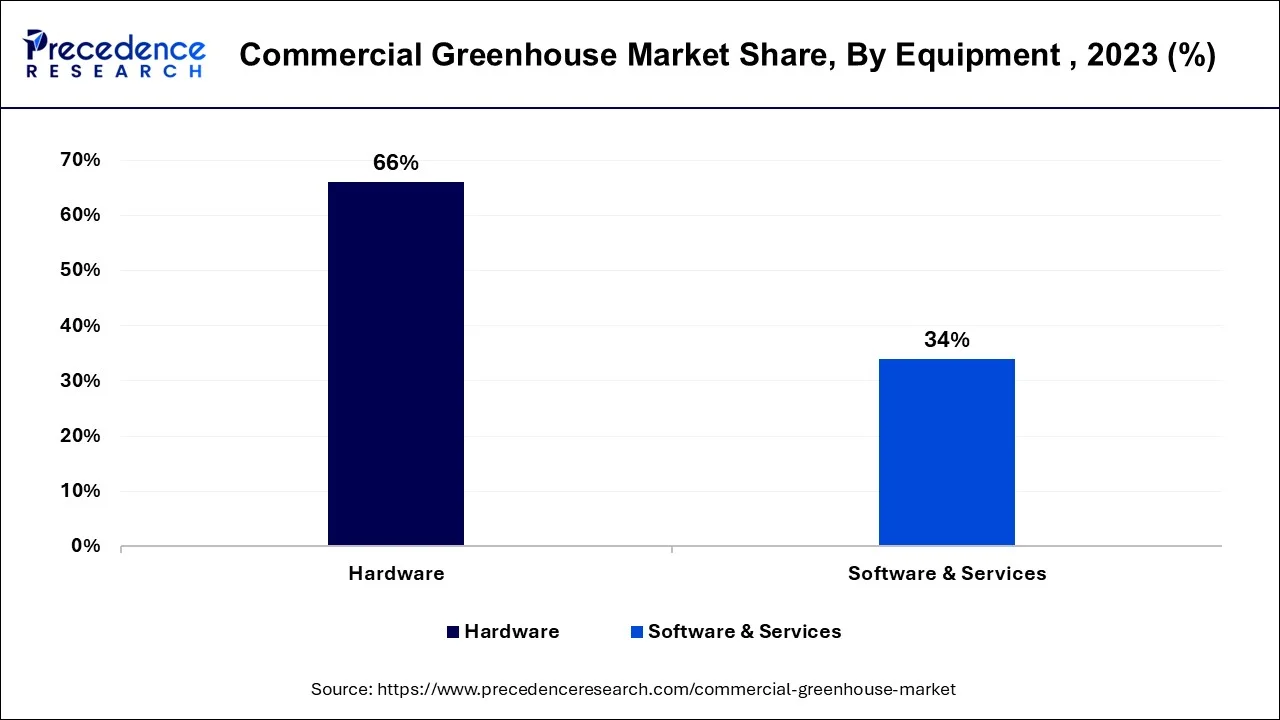
The best way to maintain the proper temperature is with a heating system. These systems may be administered centrally or decentralized. In colder months, greenhouses commonly use radiant hot water heating systems to keep their interiors warm. Because flow control enables effective temperature adjustment, these heating systems use mixing valves to regulate the temperature of the heating pipes.
Crop Type Insights
Vegetables are predicted to see the highest CAGR increase throughout the course of the projection period. Vegetables do well in greenhouse environments. Without having to worry about the climate, temperature, or other environmental changes, vegetables may be cultivated all year round. Vegetables produced in greenhouses are protected from bad weather, such as cold, wind, pests, drought, searing heat, and animals that would want to eat them. Growing vegetables there also permits the establishment of the optimal circumstances for the crops due to the regulating factors present in greenhouses, such as humidity, light, temperature, fertilizer, moisture, and irrigation.
Type Insights
The market for plastic greenhouses is predicted to grow more swiftly than that for glass greenhouses. To make commercial greenhouse plastic more durable than traditional plastic, a distinct manufacturing process is used. The unique design of this material makes it resistant to tearing and extreme weather conditions.
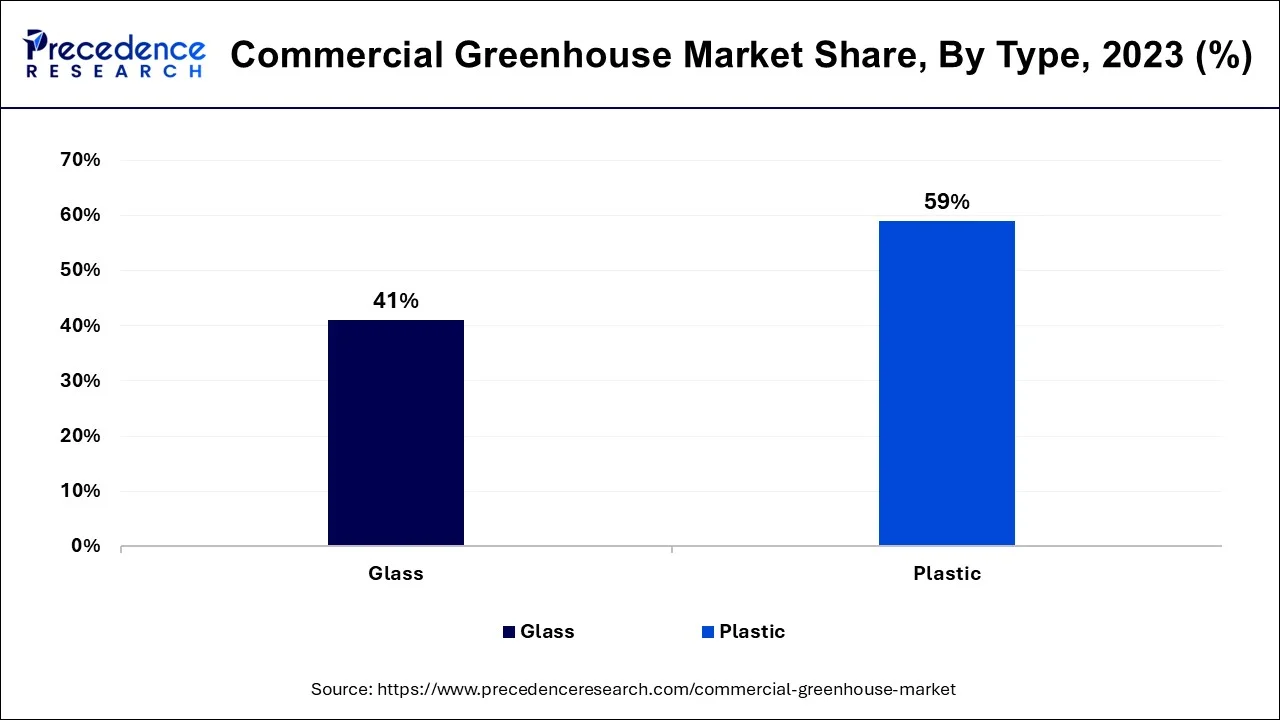
Commercial Greenhouse Market Companies
- Berry Global (US)
- Signify Holding (Netherlands)
- Heliospectra AB (Sweden)
- Plastika Kritis (Greece)
- Everlight Electronics (Taiwan)
- Richel Group (France)
- Argus Control Systems (Canada)
- Certhon (The Netherlands)
- Logiqs BV (The Netherlands)
- LumiGrow (US)
- Agra-tech, Inc (US)
- Rough Brothers, Inc (US)
- Hort Americas (US)
- Top Greenhouses (India)
- Stuppy Greenhouse (US)
- The Glasshouse Company (Australia)
- DeCloet Manufacturing Ltd (Canada)
- Europrogress (Italy)
- Luiten Greenhouses (New Zealand)
- Sotrafa (Spain)
- Nobutec BV (The Netherlands)
- Ammerlaan Constructions (The Netherlands)
- Ludy Greenhouse (US)
- Saveer Biotech Ltd (India)
- Harford (New Zealand)
Recent Developments
- In March 2025, Source.ag launches new product tiers to accelerate AI adoption in greenhouse operations. These new offerings are designed to help growers unlock significant growth, scale and become more profitable by integrating AI-driven solutions into daily greenhouse operations.
- In March 2024, Central Life Sciences launches ClearLeaf Insecticide/Miticide into commercial greenhouse market. ClearLeaf Insecticide/Miticide can be applied in greenhouses, lathe/shade houses and field-grown ornamentals as part of an integrated pest management program
- In March 2024, Mastronardi , has launched a large-format, greenhouse-grown Romaine lettuce under its Backyard Farms lettuce line. Mastronardi Produce is currently the only greenhouse grower to venture into the large-format Romaine segment and produce a high-quality product. Backyard Farms Romaine lettuce is already on shelves at select retailers.
- On 5 May 2025, Rivenhall Greenhouse Ltd. announced plans to construct a 40 hector 40-hectare greenhouse facility in Essex, UK. This project aims to reduce the UK's reliance on imported tomatoes by producing approximately 30,000 tonnes annually. The greenhouse will utilize heat, electricity, and COâ‚‚ from a nearby incinerator, offering stable energy prices and creating around 500 jobs.
- In March 2024, Heliospectra AB received an order worth 8.3 million SEK from a leading greenhouse grower in Ontario, Canada. The order includes the MITRA X LED lighting system and helioCORE control solution, aimed at enhancing energy efficiency and crop yield. Deliveries are scheduled throughout 2024 and 2025.
- In January 2024, Lassana Agri initiated a large-scale greenhouse cultivation project covering 10,000 hectares. The project aims to transition farmers to modern agriculture practices, providing advanced greenhouse solutions and financial support to enhance production and sustainability.
- Why Denso invested in Certhon Group in April 2020 to provide customers cutting-edge greenhouse solutions. The second-largest provider of automotive technology in the world is Denso.
- Madar Farms and Certhon Group agreed to work together to build a commercial indoor agricultural facility in the United Arab Emirates in January 2020.
- In order to deliver autonomous and plant-centric solutions for environmental management in greenhouses to cannabis cultivars in North America, Argus Controls and Urban-Gro extended their strategic partnership in 2019.
Segments Covered in the Report
By Equipment
- Hardware
- Software & Services
By Crop Type
- Fruits
- Vegetables
- Flowers and Ornamentals
- Nursey Crops
- Other
By Type
- Glass
- Plastic
By Component
- High-Tech Commercial Greenhouse
- Medium-Tech Commercial Greenhouse
- Low-Tech Greenhouse
By Geography
- North America
- Europe
- Asia-Pacific
- Latin America
- Middle East & Africa (MEA)
For inquiries regarding discounts, bulk purchases, or customization requests, please contact us at sales@precedenceresearch.com
Frequently Asked Questions
Ask For Sample
No cookie-cutter, only authentic analysis – take the 1st step to become a Precedence Research client